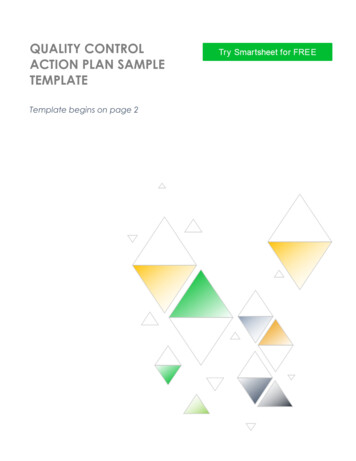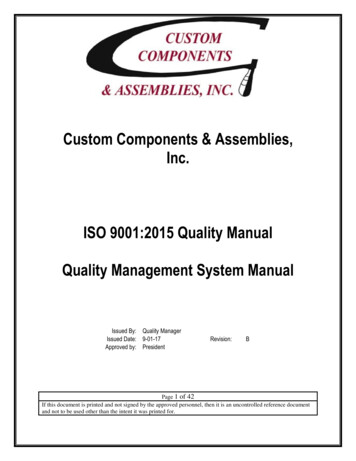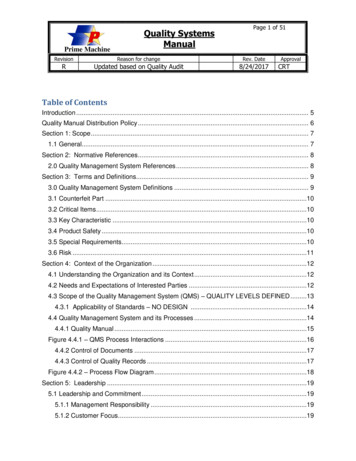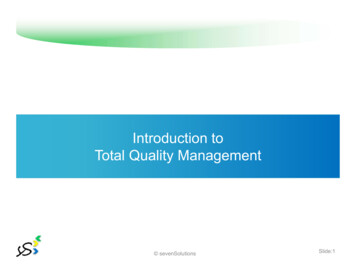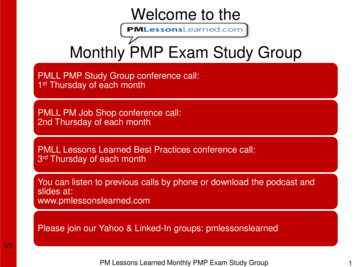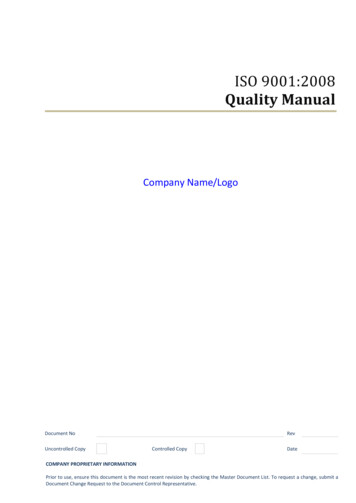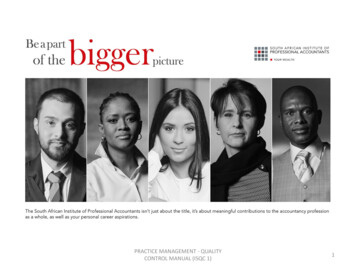
Transcription
PRACTICE MANAGEMENT - QUALITYCONTROL MANUAL (ISQC 1)1
PRACTICE MANAGEMENTQuality Control Manual (ISQC 1)CPD – PractitionersApril 2018PRACTICE MANAGEMENT - QUALITYCONTROL MANUAL (ISQC 1)2
Quality - DefinitionPRACTICE MANAGEMENT - QUALITYCONTROL MANUAL (ISQC 1)3
Quality - DefinitionQuality has various definitions and interpretations – thefollowing are but a selected few: Quality is a perception Quality is not a number Quality is about meeting and/or exceeding expectations Quality is conformance to standards Quality is rendering value for money services/goods“Quality is a product or service is not what the supplierputs in. It is what the customer gets out and is willing topay”Peter DruckerPRACTICE MANAGEMENT - QUALITYCONTROL MANUAL (ISQC 1)4
Quality Assurance vs Quality ControlQuality Assurance: Involves the continuous monitoring& evaluation throughout the process– process checklists or audits Is a preventative strategyimplemented to minimize risks Professionals are able to determinewhether the engagementdeliverables are acceptable basedon the procedures applied to createit – reviewing the work performedto draft the financial statements forcompliance to IFRS for SMEsPRACTICE MANAGEMENT - QUALITYCONTROL MANUAL (ISQC 1)5
Quality Assurance vs Quality ControlQuality Control: Involves the process ofevaluating the end result /products – focus on the output Is a detection strategyimplemented to identify risks ornon-conformance Professionals are not able todetermine whether theengagement deliverables areacceptable – checking financialstatements for compliance toIFRS for SMEsPRACTICE MANAGEMENT - QUALITYCONTROL MANUAL (ISQC 1)6
Quality Management Quality management is the system,procedures, methods and techniquesthat an organisation / practiceimplement to ensure that therequirements and standards place onit met. Quality Management system includesboth quality assurance and qualitycontrol processes ISQC 1 – Quality Control Standardoutline the key areas that should beincluded in a Quality ManagementSystemPRACTICE MANAGEMENT - QUALITYCONTROL MANUAL (ISQC 1)7
ISQC 1 - OverviewPRACTICE MANAGEMENT - QUALITYCONTROL MANUAL (ISQC 1)8
Quality Control ManualStaff - Compliance with: Professional Standards & Regulations Competent & Experienced for the engagementEngagement – Compliance with: Engagement Standard & Procedures Ethical & Professional ConductReports – Appropriate for: For the engagement Comply with Engagement StandardPRACTICE MANAGEMENT - QUALITYCONTROL MANUAL (ISQC 1)9
Quality Control ManualCode of Conduct1. Integrity2. Objectivity3. Due care4. Confidentiality5. ConductCode of Ethics1. Public Interest2. Behaviour3. Ethical dilemma4. ReportingPRACTICE MANAGEMENT - QUALITYCONTROL MANUAL (ISQC 1)Engagement:1. Standards2. Procedures3. Reports10
Quality Control ManualPractitioner’s quality control objective – quality of servicedeliveryEngagement objective – compliance with engagementstandardsFinancial statement objective – fair representation andreliabilityRegulatory objective – compliance, conduct and reporting(NOCLAR)PRACTICE MANAGEMENT - QUALITYCONTROL MANUAL (ISQC 1)11
Quality Control ManualDocumentation – policies & procedures to ensurecompliance with internal process & professional standardsComponents – comply with ISQC 1 where relevant andappropriateEngagements – procedures and supportingdocumentation (working papers)Communication – staff awareness and training as well asnotification of changesPRACTICE MANAGEMENT - QUALITYCONTROL MANUAL (ISQC 1)12
Leadership - OverviewInternal cultureProfessional values& attitudeCommitmentLeadershipQualityPRACTICE MANAGEMENT - QUALITYCONTROL MANUAL (ISQC 1)13
Leadership – StructurePrincipal:Ultimateresponsibility forqualityQuality Control Officer:Operationalresponsibility for thequality control systemEngagement Partner:Responsible for the execution of theengagement in terms of the qualitycontrol manualPRACTICE MANAGEMENT - QUALITYCONTROL MANUAL (ISQC 1)14
Leadership – Internal CultureCommitment to quality – importance of qualitythroughout the organisation & all staffPolicies & procedures – performance evaluation andpromotion linked to qualityResponsibility – commercial consideration should notoverride quality of work performedInvestment – allocation of resources for the development,documentation & support of quality management systemsPRACTICE MANAGEMENT - QUALITYCONTROL MANUAL (ISQC 1)15
Leadership - ResponsibilitiesResponsibilityof all staff atall levelsTraining is keyQualityControlAllocation ofresourcesQuality is notcompromisedApplyproceduresconsistentlyPRACTICE MANAGEMENT - QUALITYCONTROL MANUAL (ISQC 1)16
Leadership – Quality Control OfficerAppointment criteria: Experience in quality control Specialist knowledge in quality control Quality control for industries Business & professional ethics Authority within the practice Application of ISQC 1Risk consideration: Involvement in engagement team Involvement in monitoring process Involvement in Quality ReviewsPRACTICE MANAGEMENT - QUALITYCONTROL MANUAL (ISQC 1)17
Leadership – Quality Control OfficerResponsibilities: Changes in professional standards Review of quality control systems Compliance to quality control systems Risk associated with engagements Improve quality control systemsLeadership: Communication & distribution ofquality control processes Conducting training of staff Conducting induction of staffPRACTICE MANAGEMENT - QUALITYCONTROL MANUAL (ISQC 1)18
Leadership – Quality Control OfficerEthics: Staff training on Code of Ethics Maintain a register of threats toindependence Maintain a register of threats toengagement standards Procedures to identify and reportethical dilemmas Maintain a register of clients’ risksEngagement performance: Compliance to professional standards Maintain performance review reportsPRACTICE MANAGEMENT - QUALITYCONTROL MANUAL (ISQC 1)19
Planning MeetingQuality ControlSystemsEthics dependence &Conflict ofInterestPRACTICE MANAGEMENT - QUALITYCONTROL MANUAL (ISQC 1)20
Relevant Ethical RequirementsProfessionaljudgementEthical PrinciplesAttitude & EthicalbehaviourEthical RequirementsPublic InterestPRACTICE MANAGEMENT - QUALITYCONTROL MANUAL (ISQC 1)21
Relevant Ethical tsPRACTICE MANAGEMENT - QUALITYCONTROL MANUAL (ISQC 1)22
Relevant Ethical RequirementsCompliance toIEASBActions fornoncomplianceCompliance toindependenceEthicalRequirementsInvestigationof ethicalissuesThreats toethicsReporting ofethicaldilemmasPRACTICE MANAGEMENT - QUALITYCONTROL MANUAL (ISQC 1)23
Acceptance & ContinuanceRelationships between clients andprofessional accountants are oftenestablished over several years: provide high-quality client service compromising situation - continuedbusiness association may need tobe reconsideredPolicies with respect to acceptanceand continuance of client relationshipsbe linked with independenceconsiderations.PRACTICE MANAGEMENT - QUALITYCONTROL MANUAL (ISQC 1)24
Acceptance & ContinuanceCompetence: staff assigned to the engagement arecompetent and have the relevant knowledge & experienceResources: practice has the resources (staff, time andother) to execute the engagementEthics: ability to comply with the ethical andindependence requirementsRisk: consider the risk of the client (integrity) and its fitwith the practice’s risk profilePRACTICE MANAGEMENT - QUALITYCONTROL MANUAL (ISQC 1)25
Acceptance & ContinuanceContinuance:New client:1. Prior findings2. Changes3. Payment4. Risk/reputation5. Staff turnover1. Risk assessment2. Risk profile fit3. Engagement4. Resources5. ExpectationsPRACTICE MANAGEMENT - QUALITYCONTROL MANUAL (ISQC 1)Engagement:1. Nature & type2. Risk3. Competence4. Use of reports5. Distribution26
Continuance of EngagementFindings: assess the type & nature of findings in terms ofrisks and management’s response to addressing itChanges in business: assess the changes in terms of itsrisks on & competence requires for the engagementFinancial status: assess the ability of the client to meetits financial obligations for the engagementConflict of interest: assess conflict of interest,independence & ethical considerationsPRACTICE MANAGEMENT - QUALITYCONTROL MANUAL (ISQC 1)27
Acceptance of New ClientsPreviousprofessionalpractitionerClient’s riskassessEngagement riskassessmentConflict ofinterest &independenceRisk profile fit ofpracticePRACTICE MANAGEMENT - QUALITYCONTROL MANUAL (ISQC 1)28
Acceptance of New oryconsiderationsCompetence &resourcerequirementsEngagementrisks assessmentConflict ofinterest &independencePRACTICE MANAGEMENT - QUALITYCONTROL MANUAL (ISQC 1)29
Human ResourcesThe practice require sufficientemployees with the capabilities,competence, and commitment toethical principles necessary toperform engagements inaccordance with professionalstandards and regulatory and legalrequirements, so as to enable theprofessional practitioner to issuereports that are appropriate in thecircumstances.PRACTICE MANAGEMENT - QUALITYCONTROL MANUAL (ISQC 1)30
Human ResourcesRecruitment &inductionPerformanceevaluation ionaleducation (IPD)Work experience(skillsdevelopment)PRACTICE MANAGEMENT - QUALITYCONTROL MANUAL (ISQC 1)31
Engagement PerformancePolicies and procedures are designedto provide reasonable assurance thatengagements are performed inaccordance with professionalstandards and applicable legal andregulatory requirements, and thatreports issued are appropriate in thecircumstances. Such policies andprocedures shall include: Promoting consistency in thequality of engagementperformance; Supervision responsibilities; and Review responsibilities.PRACTICE MANAGEMENT - QUALITYCONTROL MANUAL (ISQC 1)32
Engagement PerformanceDiscuss findings& impact onreportsCompliance toquality controlprocessesReview reports appropriatenessReviewsupportingdocumentationReview financialstatements &reportsPRACTICE MANAGEMENT - QUALITYCONTROL MANUAL (ISQC 1)33
Monitoring Quality Control SystemEstablish a monitoring process designed to provide reasonableassurance that the policies and procedures relating to the system ofquality control are relevant, adequate, and operating effectively.This process shall: Ongoing consideration and evaluation of the system of qualitycontrol including, on a cyclical basis, inspection of at least onecompleted engagement; Responsibility for the monitoring process to be assigned to aperson with sufficient and appropriate experience andauthority; and Person performing the quality control review is not involved ininspecting the engagements.PRACTICE MANAGEMENT - QUALITYCONTROL MANUAL (ISQC 1)34
Monitoring Quality Control SystemProcedures formonitoringCommunicatechanges to staffUpdate qualitycontrol manualNon-compliancefindingsRemedial &disciplinaryactionPRACTICE MANAGEMENT - QUALITYCONTROL MANUAL (ISQC 1)35
DocumentationDocumentquality controlsystemWorking papersto supportmonitoringDestruction ofworking papersRemedial &disciplinaryactionsRetention ofworking papersPRACTICE MANAGEMENT - QUALITYCONTROL MANUAL (ISQC 1)36
PRACTICE MANAGEMENT - QUALITYCONTROL MANUAL (ISQC 1)37
Quality Management Quality management is the system, procedures, methods and techniques that an organisation / practice implement to ensure that the requirements and standards place on it met. Quality Management system includes both quality assurance and quality control processes ISQC 1 -Quality Control Standard
